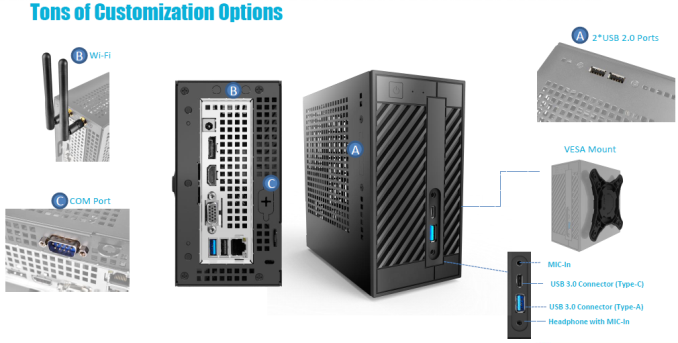ASRock DeskMini 110 mini-STX PC Review
by Ganesh T S on June 8, 2016 8:45 AM ESTConcluding Remarks
The ASRock DeskMini 110 gave us the opportunity to check out what is possible with the mini-STX form factor and a high-TDP Skylake CPU. It is quite clear that Intel's current marketing angle with the mini-STX form factor is affordability. Otherwise, it is difficult to explain why almost all vendors have gone in for a H110 chipset-based design for their mini-STX offerings. That said, ASRock has put in a couple of good differentiating aspects in the DeskMini 110: support for 65W TDP CPUs and a M.2 PCIe slot for SSDs directly connected to the CPU's PCIe lanes. This works around the issue of the H110 chipset having only PCIe 2.0 lanes
The pricing is very competitive - $130 for the all-metal chassis, 120W power adapter and cord, and the H110 motherboard. While the assembly is not as easy as that of a NUC, it is acceptable for the DIY market.
In terms of scope for improvement, a bundled WLAN adapter would be very welcome. Sourcing one that can fit in with the chassis design will be a challenge, as most M.2 PCIe WLAN modules are either meant for NUCs, or for notebooks. The DeskMini's all-metal chassis makes it difficult to get a suitable placement for the flat antennae that come with such WLAN adapters. I think it would be better for ASRock to bundle / pre-install a WLAN module and antennas for a slight increase in the price of the product. The DeskMini could also do with some additional I/O (say, a SD card reader).
It is great to see the mini-STX form factor getting broad vendor support. We would like it more if vendors were able to differentiate their offerings. ASRock has tried out a few things differently in the storage subsystem and chassis design with the DeskMini 110. We look forward to seeing what other differentiation aspects come out in the future iterations in this product line.












85 Comments
View All Comments
dj_aris - Wednesday, June 8, 2016 - link
What if mini-STX boards came with an MXM slot? That would spawn a really fresh and interesting form factor...DanNeely - Wednesday, June 8, 2016 - link
Unless the OEM was also able to solve the problem of MXM cards not being readily available on the aftermarket (and what is available tending to be obscenely priced) I suspect it'd be more likely to spawn frustration and rage.bill.rookard - Wednesday, June 8, 2016 - link
Well, that's the point of putting it out there. If you make it available, and people do start to use it, companies will start to produce boards for it, competition ensues, prices drop and availability goes up.nathanddrews - Wednesday, June 8, 2016 - link
But MXM has been available for over a decade (laptops) and it hasn't helped anything. I still remember trying to upgrade my Dell laptop to a 7950GTX and the MXM chip was $900 on eBay. even now, the 980M is over $800. If it hasn't caught on by now...xchaotic - Wednesday, June 8, 2016 - link
Basically MXM, if priced exactly the same as desktop PCIE boards should give vendors more margin. So IMO MXM should be prices identically to their big cousins and that wouldn't be bad for both consumers and OEMswolrah - Wednesday, June 8, 2016 - link
Except that it would make no sense for them to be priced the same considering the same parts would have to be packed much more densely in to the MXM board compared to a desktop board.That's like saying a laptop should be the same price as a comparable desktop + monitor + keyboard + touchpad.
xenol - Wednesday, June 8, 2016 - link
Probably the reason why MXM boards are so expensive is that there are no official markets for them. People complain why Mini-ITX boards can be as pricey as ATX boards or why SFX power supplies are as pricey as ATX ones. They're probably pricey because there's a niche demand for them (though I'd argue mITX boards tend to have more core features than ATX ones)Morawka - Wednesday, June 8, 2016 - link
No cooling fan, no heatsink, no display outputs, reduced bill of materialsNamisecond - Wednesday, July 6, 2016 - link
You're asking for 80 square inches of board real estate to be miniaturized and crammed into about 5., and then to be sold at the same rate as that bigger item.You may as well demand all labor to be priced at the same rate as that of a Shenzhen assembly line worker.
barleyguy - Wednesday, June 8, 2016 - link
I had an Asus laptop with an MXM slot. The major problem there was compatibility. Asus put custom firmware on the boards that was required for the computer to function. Basically the first 512K (I think) of the firmware was Asus specific, and the remaining part came from NVidia.I think that's been the issue with MXM all along: You can't just buy any laptop with the slot, buy any card for the slot, and expect it to work without serious technical wizardry.
Low profile PCI Express probably makes more sense. It wouldn't greatly increase the size of a box like this.